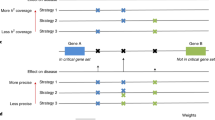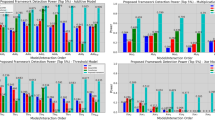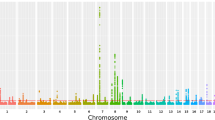Abstract
A recent association scan using a genome-wide set of nonsynonymous coding single-nucleotide polymorphisms (nsSNPs) conducted in four diseases including Graves' disease (GD), identified nine novel possible regions of association with GD. We used a case–control approach in an attempt to replicate association of these nine regions in an independent collection of 1578 British GD patients and 1946 matched Caucasian controls. Although none of these loci showed evidence of association with GD in the independent data set, when combined with the original Wellcome Trust Case–Control Consortium study group, minor differences in allele frequencies (P⩾10−3) remained in the combined collection of 5924 subjects for four of the nsSNPs, present within HDLBP, TEKT1, JSRP1 and UTX. An additional 29 Tag SNPs were screened within these four gene regions to determine if further associations could be detected. Similarly, minor differences only (P=0.042–0.002) were detected in two HDLBP and two TEKT1 Tag SNPs in the combined UK GD collection. In conclusion, it is unlikely that the SNPs selected in this replication study have a significant effect on the risk of GD in the United Kingdom. Our study confirms the need for large data sets and stringent analysis criteria when searching for susceptibility loci in common diseases.
Similar content being viewed by others
Log in or create a free account to read this content
Gain free access to this article, as well as selected content from this journal and more on nature.com
or
References
Tomer Y, Ban Y, Concepcion E et al: Common and unique susceptibility loci in Graves and Hashimoto diseases: results of whole-genome screening in a data set of 102 multiplex families. Am J Hum Genet 2003; 73: 736–747.
Taylor JC, Gough SC, Hunt PJ et al: A genome-wide screen in 1119 relative pairs with autoimmune thyroid disease. J Clin Endocrinol Metab 2006; 91: 646–653.
WTCCC: Genome-wide association study of 14 000 cases of seven common diseases and 3000 shared controls. Nature 2007; 447: 661–678.
WTCCC, TACS: Association study of 14 500 nsSNPs in four common diseases identifies variants involved in autoimmunity. Nat Genet 2007; 39: 1329–1337.
Brand OJ, Barrett J, Simmonds MJ et al: Association of the thyroid stimulating hormone receptor gene (TSHR) with Graves' disease (GD). Hum Mol Genet 2009; 18: 1704–1713.
Kochi Y, Yamada R, Suzuki A et al: A functional variant in FCRL3, encoding Fc receptor-like 3, is associated with rheumatoid arthritis and several autoimmunities. Nat Genet 2005; 37: 478–485.
Manji N, Carr-Smith JD, Boelaert K et al: Influences of age, gender, smoking, and family history on autoimmune thyroid disease phenotype. J Clin Endocrinol Metab 2006; 91: 4873–4880.
Mathews JD : Statistical aspects of immunogenetic association with disease. in Simons MJ, Tait BD (eds):: Detection of Immune-Associated Genetic Markers of Human Disease. London: Churchill Livingstone, 1984, pp 106–136.
Simmonds MJ, Howson JM, Heward JM et al: A novel and major association of HLA-C in Graves′ disease that eclipses the classical HLA-DRB1 effect. Hum Mol Genet 2007; 16: 2149–2153.
Simmonds MJ, Howson JM, Heward JM et al: Regression mapping of association between the human leukocyte antigen region and Graves disease. Am J Hum Genet 2005; 76: 157–163.
Ueda H, Howson JM, Esposito L et al: Association of the T-cell regulatory gene CTLA4 with susceptibility to autoimmune disease. Nature 2003; 423: 506–511.
Heward J, Brand O, Barrett J, Carr-Smith J, Franklyn J, Gough S : Association of PTPN22 haplotypes with Graves' disease. J Clin Endocrinol Metab 2006; 92: 685–690.
Velaga MR, Wilson V, Jennings CE et al: The codon 620 tryptophan allele of the lymphoid tyrosine phosphatase (LYP) gene is a major determinant of Graves′ disease. J Clin Endocrinol Metab 2004; 89: 5862–5865.
Brand OJ, Lowe CE, Heward JM et al: Association of the interleukin-2 receptor alpha (IL-2Rα)/CD25 gene region with Graves′ disease using a multilocus test and tag SNPs. Clin Endocrinol (Oxf) 2007; 66: 508–512.
Simmonds MJ, Heward JM, Franklyn JA, Gough SC : The CD40 Kozak SNP: a new susceptibility loci for Graves′ disease? Clin Endocrinol (Oxf) 2005; 63: 232–233.
Jacobson EM, Huber AK, Akeno N et al: A CD40 Kozak sequence polymorphism and susceptibility to antibody-mediated autoimmune conditions: the role of CD40 tissue-specific expression. Genes Immun 2007; 8: 205–214.
Collins JE, Heward JM, Howson JM et al: Common allelic variants of exons 10, 12, and 33 of the thyroglobulin gene are not associated with autoimmune thyroid disease in the United Kingdom. J Clin Endocrinol Metab 2004; 89: 6336–6339.
Ban Y, Greenberg DA, Concepcion E, Skrabanek L, Villanueva R, Tomer Y : Amino acid substitutions in the thyroglobulin gene are associated with susceptibility to human and murine autoimmune thyroid disease. Proc Natl Acad Sci USA 2003; 100: 15119–15124.
Todd JA, Walker NM, Cooper JD et al: Robust associations of four new chromosome regions from genome-wide analyses of type 1 diabetes. Nat Genet 2007; 39: 857–864.
Cooper JD, Smyth DJ, Smiles AM et al: Meta-analysis of genome-wide association study data identifies additional type 1 diabetes risk loci. Nat Genet 2008; 40: 1399–1401.
Acknowledgements
We would like to thank all patients, nurses and doctors for recruiting into the AITD National Collection. We wish to acknowledge the WTCCC and the Wellcome Trust for funding. We acknowledge use of DNA from the British 1958 Birth Cohort Collection, funded by the Medical Research Council grant G0000934 and the Wellcome Trust grant 068545/Z/02.
Author information
Authors and Affiliations
Consortia
Corresponding author
Ethics declarations
Competing interests
The authors declare no conflict of interest.
Additional information
Supplementary Information accompanies the paper on European Journal of Human Genetics website
Supplementary information
Appendix
Appendix
Membership of WTCCC
Membership of the Wellcome Trust Case–Control Consortium (WTCCC)
Management Committee: Paul R Burton1, David G Clayton2, Lon R Cardon3, Nick Craddock4, Panos Deloukas5, Audrey Duncanson6, Dominic P Kwiatkowski3,5, Mark I McCarthy3,7, Willem H Ouwehand8,9, Nilesh J Samani10, John A Todd2, Peter Donnelly (Chair)11
Analysis Committee: Jeffrey C Barrett3, Paul R Burton1, Dan Davison11, Peter Donnelly11, Doug Easton12, David Evans3, Hin-Tak Leung2, Jonathan L Marchini11, Andrew P Morris3, I CA Spencer11, Martin D Tobin1, Lon R Cardon (co-chair)3, David G Clayton (co-chair)2
UK Blood Services and University of Cambridge Controls: Antony P Attwood5,8, James P Boorman8,9, Barbara Cant8, Ursula Everson13, Judith M Hussey14, Jennifer D Jolley8, Alexandra S Knight8, Kerstin Koch8, Elizabeth Meech15, Sarah Nutland2, Christopher V Prowse16, Helen E Stevens2, Niall C Taylor8, Graham R Walters17, Neil M Walker2, Nicholas A Watkins8,9, Thilo Winzer8, John A Todd2, Willem H Ouwehand8,9
1958 Birth Cohort Controls: Richard W Jones18, Wendy L McArdle18, Susan M Ring18, David P Strachan19, Marcus Pembrey18,20
Bipolar Disorder: Aberdeen – Gerome Breen21, David St Clair21; Birmingham – Sian Caesar22, Katherine Gordon-Smith22,23, Lisa Jones22; Cardiff – Christine Fraser23, Elaine K Green23, Detelina Grozeva23, Marian L Hamshere23, Peter A Holmans23, Ian R Jones23, George Kirov23, Valentina Moskvina23, Ivan Nikolov23, Michael C O'Donovan23, Michael J Owen23, Nick Craddock23; London – David A Collier24, Amanda Elkin24, Anne Farmer24, Richard Williamson24, Peter McGuffin24; Newcastle – Allan H Young25, I Nicol Ferrier25
Coronary Artery Disease: Leeds – Stephen G Ball26, Anthony J Balmforth26, Jennifer H Barrett26, D Timothy Bishop26, Mark M Iles26, Azhar Maqbool26, Nadira Yuldasheva26, Alistair S Hall26; Leicester – Peter S Braund10, Paul R Burton1, Richard J Dixon10, Massimo Mangino10, Suzanne Stevens10, Martin D Tobin1, John R Thompson1, Nilesh J Samani10
Crohn's Disease: Cambridge – Francesca Bredin27, Mark Tremelling27, Miles Parkes27; Edinburgh – Hazel Drummond28, Charles W Lees28, Elaine R Nimmo28, Jack Satsangi28; London – Sheila A Fisher29, Alastair Forbes30, Cathryn M Lewis29, Clive M Onnie29, Natalie J Prescott29, Jeremy Sanderson31, Christopher G Mathew29; Newcastle – Jamie Barbour32, M Khalid Mohiuddin32, Catherine E Todhunter32, John C Mansfield32; Oxford – Tariq Ahmad33, Fraser R Cummings33, Derek P Jewell33
Hypertension: Aberdeen – John Webster34; Cambridge – Morris J Brown35, David G Clayton2; Evry, France – G Mark Lathrop36; Glasgow – John Connell37, Anna Dominiczak37; Leicester – Nilesh J Samani10; London – Carolina A Braga Marcano38, Beverley Burke38, Richard Dobson38, Johannie Gungadoo38, Kate L Lee38, Patricia B Munroe38, Stephen J Newhouse38, Abiodun Onipinla38, I Wallace38, Mingzhan Xue38, Mark Caulfield38; Oxford – Martin Farrall39
Rheumatoid Arthritis: Anne Barton40, The Biologics in RA Genetics and Genomics Study Syndicate (BRAGGS) Steering Committee, Ian N Bruce40, Hannah Donovan40, Steve Eyre40, Paul D Gilbert40, Samantha L Hider40, Anne M Hinks40, Sally L John40, Catherine Potter40, Alan J Silman40, Deborah PM Symmons40, Wendy Thomson40, Jane Worthington40
Type 1 Diabetes: David G Clayton2, David B Dunger2,41, Sarah Nutland2, Helen E Stevens2, Neil M Walker2, Barry Widmer2,41, John A Todd2
Type 2 Diabetes: Exeter – Timothy M Frayling42,43, Rachel M Freathy42,43, Hana Lango42,43, John R B Perry42,43, Beverley M Shields43, Michael N Weedon42,43, Andrew T Hattersley42,43; London – Graham A Hitman44; Newcastle – Mark Walker45; Oxford – Kate S Elliott3,7, Christopher J Groves7, Cecilia M Lindgren3,7, Nigel W Rayner3,7, Nicholas J Timpson3,46, Eleftheria Zeggini3,7, Mark I McCarthy3,7
Tuberculosis: Gambia – Melanie Newport47, Giorgio Sirugo47; Oxford – Emily Lyons3, Fredrik Vannberg3, Adrian VS Hill3
Ankylosing Spondylitis: Linda A Bradbury48, Claire Farrar49, Jennifer J Pointon48, Paul Wordsworth49, Matthew A Brown48,49
AutoImmune Thyroid Disease: Jayne A Franklyn50, Joanne M Heward50, Matthew J Simmonds50, Stephen CL Gough50
Breast Cancer: Sheila Seal51, Breast Cancer Susceptibility Collaboration (UK)*, Michael R Stratton51,52, Nazneen Rahman51
Multiple Sclerosis: Maria Ban53, An Goris53, Stephen J Sawcer53, Alastair Compston53
Gambian Controls: Gambia – David Conway47, Muminatou Jallow47, Melanie Newport47, Giorgio Sirugo47; Oxford – Kirk A Rockett3, Dominic P Kwiatkowski3,5
DNA, Genotyping, Data QC and Informatics: Wellcome Trust Sanger Institute, Hinxton – Claire Bryan5, Suzannah J Bumpstead5, Amy Chaney5, Kate Downes2,5, Jilur Ghori5, Rhian Gwilliam5, Sarah E Hunt5, Michael Inouye5, Andrew Keniry5, Emma King5, Ralph McGinnis5, Simon Potter5, Rathi Ravindrarajah5, Pamela Whittaker5, David Withers5, Panos Deloukas5; Cambridge – Hin-Tak Leung2, Sarah Nutland2, Helen E Stevens2, Neil M Walker2, John A Todd2
Statistics: Cambridge – Doug Easton12, David G Clayton2; Leicester – Paul R Burton1, Martin D Tobin1; Oxford – Jeffrey C Barrett3, David Evans3, Andrew P Morris3, Lon R Cardon3; Oxford – Niall J Cardin11, Dan Davison11, Teresa Ferreira11, Joanne Pereira-Gale11, Ingeleif B Hallgrimsdóttir11, Bryan N Howie11, Jonathan L Marchini11, I CA Spencer11, Zhan Su11, Yik Ying Teo3,11, Damjan Vukcevic11, Peter Donnelly11
PIs: David Bentley5,54, Matthew A Brown48,49, Lon R Cardon3, Mark Caulfield38, David G Clayton2, Alistair Compston53, Nick Craddock23, Panos Deloukas5, Peter Donnelly11, Martin Farrall39, Stephen CL Gough50, Alistair S Hall26, Andrew T Hattersley42,43, Adrian VS Hill3, Dominic P Kwiatkowski3,5, Christopher G Mathew29, Mark I McCarthy3,7, Willem H Ouwehand8,9, Miles Parkes27, Marcus Pembrey18,20, Nazneen Rahman51, Nilesh J Samani10, Michael R Stratton51,52, John A Todd2, Jane Worthington40
1Genetic Epidemiology Group, Department of Health Sciences, University of Leicester, Adrian Building, University Road, Leicester LE1 7RH, UK; 2Juvenile Diabetes Research Foundation/Wellcome Trust Diabetes and Inflammation Laboratory, Department of Medical Genetics, Cambridge Institute for Medical Research, University of Cambridge, Wellcome Trust/MRC Building, Cambridge CB2 0XY, UK; 3Wellcome Trust Centre for Human Genetics, University of Oxford, Roosevelt Drive, Oxford OX3 7BN, UK; 4Department of Psychological Medicine, Henry Wellcome Building, School of Medicine, Cardiff University, Heath Park, Cardiff CF14 4XN, UK; 5The Wellcome Trust Sanger Institute, Wellcome Trust Genome Campus, Hinxton, Cambridge CB10 1SA, UK; 6The Wellcome Trust, Gibbs Building, 215 Euston Road, London NW1 2BE, UK; 7Oxford Centre for Diabetes, Endocrinology and Medicine, University of Oxford, Churchill Hospital, Oxford OX3 7LJ, UK; 8Department of Haematology, University of Cambridge, Long Road, Cambridge CB2 2PT, UK; 9National Health Service Blood and Transplant, Cambridge Centre, Long Road, Cambridge CB2 2PT, UK; 10Department of Cardiovascular Sciences, University of Leicester, Glenfield Hospital, Groby Road, Leicester LE3 9QP, UK; 11Department of Statistics, University of Oxford, 1 South Parks Road, Oxford OX1 3TG, UK; 12Cancer Research UK Genetic Epidemiology Unit, Strangeways Research Laboratory, Worts Causeway, Cambridge CB1 8RN, UK;13National Health Service Blood and Transplant, Sheffield Centre, Longley Lane, Sheffield S5 7JN, UK; 14National Health Service Blood and Transplant, Brentwood Centre, Crescent Drive, Brentwood CM15 8DP, UK; 15The Welsh Blood Service, Ely Valley Road, Talbot Green, Pontyclun CF72 9WB, UK; 16The Scottish National Blood Transfusion Service, Ellen's Glen Road, Edinburgh EH17 7QT, UK; 17National Health Service Blood and Transplant, Southampton Centre, Coxford Road, Southampton SO16 5AF, UK; 18Avon Longitudinal Study of Parents and Children, University of Bristol, 24 Tyndall Avenue, Bristol BS8 1TQ, UK; 19Division of Community Health Services, St George's University of London, Cranmer Terrace, London SW17 0RE, UK; 20Institute of Child Health, University College London, 30 Guilford St, London WC1N 1EH, UK; 21University of Aberdeen, Institute of Medical Sciences, Foresterhill, Aberdeen AB25 2ZD, UK; 22Division of Neuroscience, Department of Psychiatry, Birmingham University, Birmingham B15 2QZ, UK; 23Department of Psychological Medicine, Henry Wellcome Building, School of Medicine, Cardiff University, Heath Park, Cardiff CF14 4XN, UK; 24King's College London, SGDP, The Institute of Psychiatry, De Crespigny Park Denmark Hill London SE5 8AF, UK; 25School of Neurology, Neurobiology and Psychiatry, Royal Victoria Infirmary, Queen Victoria Road, Newcastle upon Tyne NE1 4LP, UK; 26Faculty of Medicine and Health, LIGHT and LIMM Research Institutes, University of Leeds, Leeds LS1 3EX, UK; 27IBD Research Group, Addenbrooke's Hospital, University of Cambridge, Cambridge CB2 2QQ, UK; 28Gastrointestinal Unit, School of Molecular and Clinical Medicine, University of Edinburgh, Western General Hospital, Edinburgh EH4 2XU, UK; 29King's College London School of Medicine, Department of Medical and Molecular Genetics, 8th Floor Guy's Tower, Guy's Hospital, London SE1 9RT, UK; 30Institute for Digestive Diseases, University College London Hospitals Trust, London NW1 2BU, UK; 31Department of Gastroenterology, Guy's and St Thomas' NHS Foundation Trust, London SE1 7EH, UK; 32Department of Gastroenterology and Hepatology, University of Newcastle upon Tyne, Royal Victoria Infirmary, Newcastle upon Tyne NE1 4LP, UK; 33Gastroenterology Unit, Radcliffe Infirmary, University of Oxford, Oxford OX2 6HE, UK; 34Medicine and Therapeutics, Aberdeen Royal Infirmary, Foresterhill, Aberdeen, Grampian AB9 2ZB, UK; 35Clinical Pharmacology Unit and the Diabetes and Inflammation Laboratory, University of Cambridge, Addenbrookes Hospital, Hills Road, Cambridge CB2 2QQ, UK; 36Centre National de Genotypage, 2, Rue Gaston Cremieux, Evry, Paris 91057; 37BHF Glasgow Cardiovascular Research Centre, University of Glasgow, 126 University Place, Glasgow G12 8TA, UK; 38Clinical Pharmacology and Barts and The London Genome Centre, William Harvey Research Institute, Barts and The London, Queen Mary's School of Medicine, Charterhouse Square, London EC1M 6BQ, UK; 39Cardiovascular Medicine, University of Oxford, Wellcome Trust Centre for Human Genetics, Roosevelt Drive, Oxford OX3 7BN, UK; 40arc Epidemiology Research Unit, University of Manchester, Stopford Building, Oxford Rd, Manchester M13 9PT, UK; 41Department of Paediatrics, University of Cambridge, Addenbrooke's Hospital, Cambridge CB2 2QQ, UK; 42Genetics of Complex Traits, Institute of Biomedical and Clinical Science, Peninsula Medical School, Magdalen Road, Exeter EX1 2LU UK; 43Diabetes Genetics, Institute of Biomedical and Clinical Science, Peninsula Medical School, Barrack Road, Exeter EX2 5DU UK; 44Centre for Diabetes and Metabolic Medicine, Barts and The London, Royal London Hospital, Whitechapel, London E1 1BB UK; 45Diabetes Research Group, School of Clinical Medical Sciences, Newcastle University, Framlington Place, Newcastle upon Tyne NE2 4HH, UK; 46The MRC Centre for Causal Analyses in Translational Epidemiology, Bristol University, Canynge Hall, Whiteladies Rd, Bristol BS2 8PR, UK; 47MRC Laboratories, Fajara, The Gambia; 48Diamantina Institute for Cancer, Immunology and Metabolic Medicine, Princess Alexandra Hospital, University of Queensland, Woolloongabba, Qld 4102, Australia; 49Botnar Research Centre, University of Oxford, Headington, Oxford OX3 7BN, UK; 50Division of Medical Sciences, Department of Medicine, Institute of Biomedical Research, University of Birmingham, Edgbaston, Birmingham B15 2TT, UK; 51Section of Cancer Genetics, Institute of Cancer Research, 15 Cotswold Road, Sutton SM2 5 NG, UK; 52Cancer Genome Project, The Wellcome Trust Sanger Institute, Wellcome Trust Genome Campus, Hinxton, Cambridge CB10 1SA, UK; 53Department of Clinical Neurosciences, University of Cambridge, Addenbrooke's Hospital, Hills Road, Cambridge CB2 2QQ, UK; 54PRESENT ADDRESS: Illumina Cambridge, Chesterford Research Park, Little Chesterford, Nr Saffron Walden, Essex CB10 1XL, UK.
Rights and permissions
About this article
Cite this article
Newby, P., Pickles, O., Mazumdar, S. et al. Follow-up of potential novel Graves' disease susceptibility loci, identified in the UK WTCCC genome-wide nonsynonymous SNP study. Eur J Hum Genet 18, 1021–1026 (2010). https://doi.org/10.1038/ejhg.2010.55
Received:
Revised:
Accepted:
Published:
Issue date:
DOI: https://doi.org/10.1038/ejhg.2010.55
Keywords
This article is cited by
-
The genetics of Graves’ disease
Reviews in Endocrine and Metabolic Disorders (2024)
-
GWAS in autoimmune thyroid disease: redefining our understanding of pathogenesis
Nature Reviews Endocrinology (2013)
-
Identification of independent risk loci for Graves’ disease within the MHC in the Japanese population
Journal of Human Genetics (2011)



